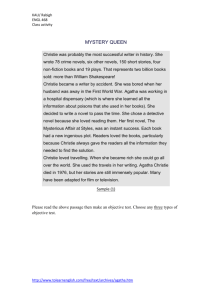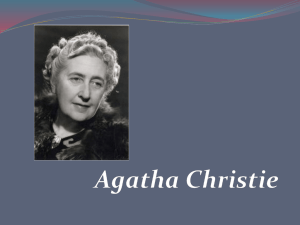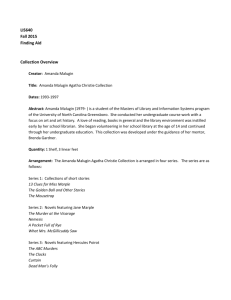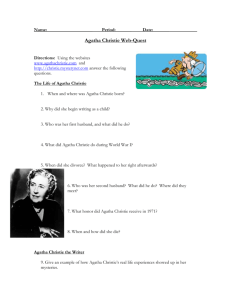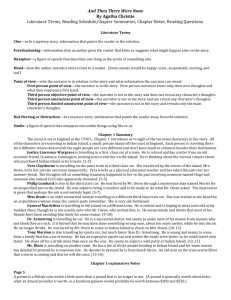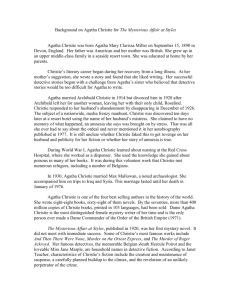Plot summary - June Wygant's Web
advertisement
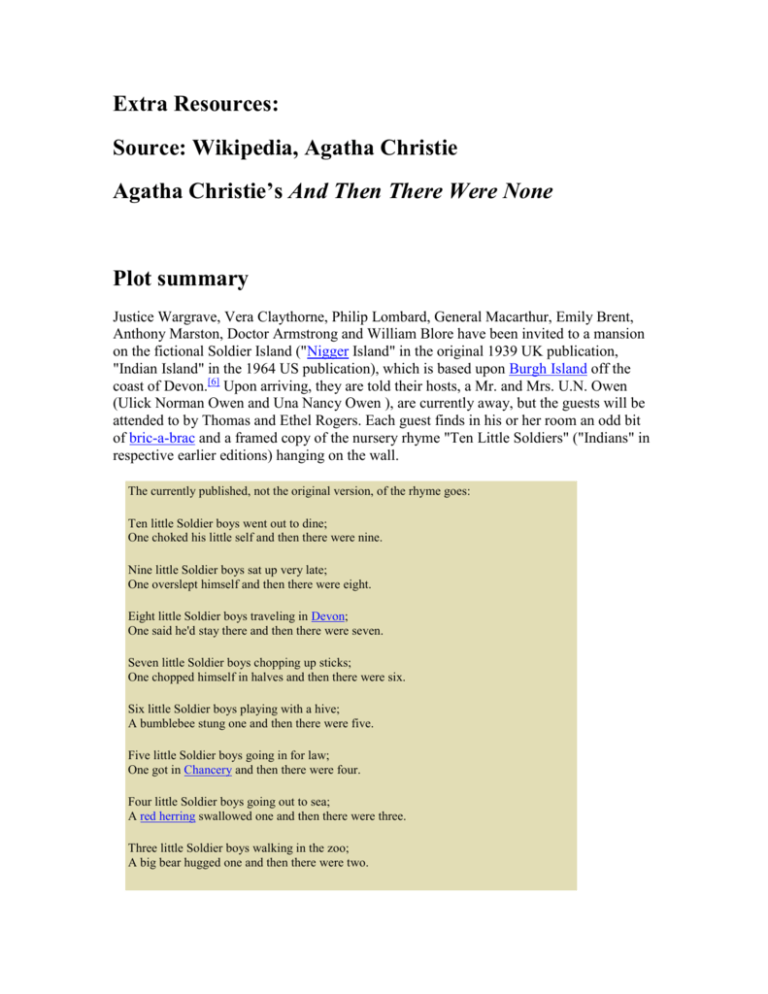
Extra Resources: Source: Wikipedia, Agatha Christie Agatha Christie’s And Then There Were None Plot summary Justice Wargrave, Vera Claythorne, Philip Lombard, General Macarthur, Emily Brent, Anthony Marston, Doctor Armstrong and William Blore have been invited to a mansion on the fictional Soldier Island ("Nigger Island" in the original 1939 UK publication, "Indian Island" in the 1964 US publication), which is based upon Burgh Island off the coast of Devon.[6] Upon arriving, they are told their hosts, a Mr. and Mrs. U.N. Owen (Ulick Norman Owen and Una Nancy Owen ), are currently away, but the guests will be attended to by Thomas and Ethel Rogers. Each guest finds in his or her room an odd bit of bric-a-brac and a framed copy of the nursery rhyme "Ten Little Soldiers" ("Indians" in respective earlier editions) hanging on the wall. The currently published, not the original version, of the rhyme goes: Ten little Soldier boys went out to dine; One choked his little self and then there were nine. Nine little Soldier boys sat up very late; One overslept himself and then there were eight. Eight little Soldier boys traveling in Devon; One said he'd stay there and then there were seven. Seven little Soldier boys chopping up sticks; One chopped himself in halves and then there were six. Six little Soldier boys playing with a hive; A bumblebee stung one and then there were five. Five little Soldier boys going in for law; One got in Chancery and then there were four. Four little Soldier boys going out to sea; A red herring swallowed one and then there were three. Three little Soldier boys walking in the zoo; A big bear hugged one and then there were two. Two Little Soldier boys sitting in the sun; One got frizzled up and then there was one.[7] One little Soldier boy left all alone; He went out and hanged himself and then there were none. Before dinner that evening, the guests notice ten soldier boy figurines on the dining room table. During their meal, a gramophone record plays, accusing each of the ten of murder. Each guest acknowledges awareness of (and in some cases involvement with) the deaths of the persons named, but denies any malice and/or legal culpability, except for Lombard. The guests now realize they have been tricked into coming to the island, but find that they cannot leave: the boat which regularly delivers supplies has stopped arriving. They are murdered one by one, each death paralleling a verse of the nursery rhyme, with one of the figurines being removed after each murder. First to die is Anthony Marston, whose drink is poisoned with cyanide ("one choked his little self"). That night, Thomas Rogers notices that a figurine is missing from the dining table. Mrs. Rogers dies in her sleep that night, which Dr. Armstrong attributes to a fatal overdose of sleeping draught ("one overslept himself"). General Macarthur fatalistically predicts that no one will leave the island alive, and at lunch, is indeed found dead from a blow to the back of his skull ("one said he'd stay there"). Meanwhile, two more figurines have disappeared from the dining room. In growing panic, the survivors search the island in vain for the murderer. Justice Wargrave establishes himself as the decisive leader of the group and asserts one of them must be the murderer playing a sadistic game with the rest. The killer's twisted humor is evidenced by the names of their "hosts": "U.N. Owen" is a pun and a homophone for "unknown". The next morning, Rogers is missing, as is another figurine. He is found dead in the woodshed, struck in the back of the head with an axe ("one chopped himself in halves"). Later that day, Emily Brent is killed in the kitchen by an injection of potassium cyanide that leaves a mark on her neck ("A bumblebee stung one"), which at first appears to be a sting from a bumble bee placed in the room. The hypodermic needle is found outside her window next to a smashed china figurine. The five survivors — Dr. Armstrong, Justice Wargrave, Philip Lombard, Vera Claythorne, and William Blore — become increasingly frightened and almost frantic. Wargrave suggests they lock up any potential weapons, including Armstrong's medical equipment and the judge's own sleeping pills. Lombard admits to bringing a revolver to the island, but says it has gone missing. Resolved to keep the killer from catching anyone alone, they gather in the drawing room and only leave one at a time. Vera goes up to her room and discovers a strand of seaweed: an allusion to the boy the gramophone alleged that she had drowned. Her screams attract the attention of Blore, Lombard, and Armstrong, who rush to her aid. When they return to the drawing room, they find Wargrave in a mockery of a judicial wig and gown with a gunshot wound in his forehead ("one got into Chancery"). Armstrong confirms the death, and they lay Wargrave's body in his room and cover it with a sheet. Shortly afterward, Lombard discovers his revolver has been returned. That night, Blore hears someone sneaking out of the house. He and Lombard investigate and, discovering Armstrong missing, assume the doctor is the killer. They wake Vera and the three spend the night outdoors. In the morning, Blore leaves for food and does not return. Vera and Lombard soon discover his body on the terrace, skull crushed by a bearshaped clock ("a big bear hugged one")—and on the shore, Armstrong, drowned ("a red herring swallowed one"). Paranoid, each assumes the other is the murderer. In the tense standoff that follows, Vera feigns compassion and has Lombard help her move Armstrong's body out of the water, using the opportunity to pick his revolver from his pocket. She kills Lombard with a shot through the heart on the beach ("sitting in the sun") and returns to the house. Dazed and disoriented with relief and drowsiness, Vera Claythorne is unsurprised to find a noose prepared in her room. In a trance of exhaustion, guilt, and relief, she hangs herself, fulfilling the final verse of the rhyme.[8] [edit] Epilogue Inspector Maine, the detective in charge of the Soldier Island case, discusses the mystery with his Assistant Commissioner, Sir Thomas Legge, at Scotland Yard. There are no clues on the mainland—the man who arranged "U.N. Owen's" purchase of the island covered his tracks well, and was killed the day the party set sail—and while guests' diaries establish a partial timeline, the police cannot determine the order in which Blore, Armstrong, Lombard, and Vera were killed. Blore could not have dropped the clock on himself; Armstrong's body was dragged above the high-tide mark; Lombard was shot on the beach, but his revolver was found outside Wargrave's room. Lombard's pistol having Vera's fingerprints and the clock that killed Blore coming from her room both point to Vera as "U.N.Owen"-yet that someone was alive after Vera's suicide is obvious since the chair Vera used to hang herself had been righted and replaced against the wall. Inclement weather would have prevented the murderer from leaving or arriving separately from the guests: he or she must have been among them. Yet all the murders appear to be accounted for, and the inspectors are confused, leaving them asking - Who killed them, and why? [edit] Postscript A fishing trawler finds a letter in a bottle just off the Devon coast; it contains the confession of the late Justice Wargrave. He reveals a lifelong sadistic temperament juxtaposed uneasily with a fierce sense of justice: he wanted to torture, terrify, and kill, but could never justify harming an innocent person. As a judge, he directed merciless summations and guilty verdicts, but limited himself to those cases in which he had satisfied himself of the guilt of the defendant(s), thrilling at the sight of the convicted person crippled with fear, facing their impending death. But the proxy of the bench was unsatisfying: Wargrave longed to commit murder by his own hand. Prompted to action by the discovery that he was terminally ill, he sought killers who had committed murder but escaped justice. He lured them to the island. As he killed them one by one, he reveled in the mounting terror of those who remained, their reactions to the murders confirming their guilt. He also murdered the guests by order of their level of guilt, first killing those whose crimes were caused by carelessness, or who felt some level of remorse, so that "...they not suffer the prolonged mental strain and fear that the more cold-blooded offenders were to suffer", and saving the most cold-blooded killers for last. (He seems to have been mistaken where Vera is concerned, however, since Vera feels the most guilt throughout the novel, though she does not show it to Wargrave) Having disposed of the first five guests, the judge then persuaded the trusting Armstrong to fake Wargrave's own death, "the red herring", under the pretext that it would rattle or unnerve the "real murderer". That night, he met Armstrong on the cliffs and pushed him into the sea, knowing the doctor's disappearance would provoke the suspicions of the others. From Vera's room, Wargrave pushed the stone bear-shaped clock onto Blore, crushing his skull. After watching Vera shoot Lombard, he then set up a noose and a chair in her bedroom assuming she would hang herself. He was right and watched Vera hang herself from the shadows. Wargrave pushed the chair she had stood on against the wall, wrote out his confession, put the letter in a bottle and tossed it out to sea. Wargrave admits to craving posthumous recognition of his scheme. Even if his letter is not found (he decides there is about a 1 in 100 chance of it being found), he felt that three clues exist implicating him, although he surmises (correctly) that the mystery will not have been solved: 1. Wargrave was the only one invited to the island who had not wrongfully caused someone's death. Edward Seton, whom the gramophone accused Wargrave of wrongfully sentencing to death, was, in fact, guilty of the murder for which he was convicted, and overwhelming proof emerged, albeit posthumously, of this. Thus, ironically, the only innocent guest must be the murderer. 2. The "red herring" line in the poem suggests that Armstrong was tricked into his death by someone he trusted. Of the remaining guests, only the respectable Justice Wargrave would have inspired the doctor's confidence. 3. The red mark on Wargrave's forehead that Armstrong confirmed as a bullet wound is similar to the one God bestowed upon Cain as punishment for killing his brother Abel. Wargrave describes how he planned to kill himself: he will loop an elastic cord through the gun, tying one end of the cord to his eyeglasses, and looping the other around the doorknob of an open door. He will then wrap a handkerchief around the handle of the gun and shoot himself in the head. His body will fall back as though laid there by Armstrong. The gun's recoil will send it to the doorknob and out into the hallway, detaching the cord and pulling the door closed. The cord will dangle innocuously from his glasses, and the stray handkerchief should not arouse suspicion. Thus the police will find ten dead bodies and an unsolvable mystery on Soldier/Indian Island. [edit] Characters The following details of the characters are based on the original novel. Stage and film adaptations have often varied with names and backgrounds, such as Judge Wargrave being renamed Cannon and Lombard accused of causing the death of his pregnant girlfriend. Anthony James Marston, a rich, spoiled, good-looking man with a wellproportioned body, crisp hair, tanned face and blue eyes known for his reckless driving. Mr. Owen accused Anthony of running over and killing two children, while drunk, for which Marston felt no remorse. Marston was the first of Owen's victims, poisoned by potassium cyanide slipped into his drink while gathered in the drawing room with the others. Mrs. Ethel Rogers, the cook and Mr. Rogers's wife. She is described as a palefaced, ghostlike woman with shifty light eyes, who is very scared of something. Despite her respectability and efficiency, she was obliged to help her domineering husband, Thomas, to kill their former employer, the elderly Miss Jennifer Brady, by withholding her medicine, in order to inherit her money. She was Owen's second victim, dying in her sleep from an overdose of chloral hydrate, which she did not self-administer. General John Gordon Macarthur, a retired World War I hero, who sent his wife's lover (a younger officer named Arthur Richmond) to his death by assigning him to a suicide mission. MacArthur fatalistically accepts that no one will leave the island alive, which he confides to Vera. Shortly thereafter, he becomes Owen's third victim, his head being crushed in as he sat along the shore. Thomas Rogers, the butler and Mrs. Rogers's husband. He and his weak-willed wife, whom he dominated, killed their former elderly employer by withholding her medicine, causing the elderly woman to die from heart failure, in order to inherit the money she had left them in her will. He was Owen's fourth victim, being struck in the head with an axe as he cut firewood in the woodshed. Emily Caroline Brent, a rigid and repressed elderly woman of harsh moralistic principles who uses The Bible to justify her inability to show compassion or understanding for others. However, she firmly believes in racial equality, stating "Black or white, they are our brothers.". She dismissed her maid, Beatrice Taylor, as punishment for becoming pregnant out of wedlock. As a result Beatrice, who had also been rejected by her own family, threw herself into a river and drowned. Miss Brent became Owen's fifth victim after being injected with a dose of potassium cyanide into her neck as she sat alone at the dining table after being drugged. Dr. Edward George Armstrong, a Harley Street surgeon, blamed for the death of his patient, Louisa Clees, while operating under the influence of alcohol. Armstrong became Owen's seventh victim after being pushed off a cliff into the sea. His body goes missing for a while, leading others to think he is the killer, but his corpse washes up at the end of the novel, leading to the climax. William Henry Blore, a retired police inspector and now a private investigator, accused of having an innocent man, James Landor, sentenced to life imprisonment as a scapegoat after having been bribed. The man later died in prison. He initially denies the accusation-although he later privately admits the truth to Lombard. Blore became Owen's perceived eighth victim, having his skull crushed by a bear-shaped clock, dropped from a window above outside the house. Philip Lombard, a soldier of fortune. Literally down to his last square meal, he comes to the island with a loaded revolver. Though he is reputed to be a good man in a tight spot, Lombard is accused of causing the deaths of a native African tribe when he stole food from the tribe, thus causing their starvation and subsequent death. Unlike the other characters, he admits openly that the accusations against him are true, but feels no remorse for his actions.Though not an actual victim of Owen's, Lombard fulfilled the ninth referenced verse of the rhyme, shot to death on the beach by Vera, who at the time believed him to be the murderer. Vera Elizabeth Claythorne, a young teacher, secretary, and ex-governess, who takes mostly secretarial jobs since her last job as a governess ended in the death of her charge, Cyril Hamilton. She let young Cyril swim out to sea and drown so that his uncle, Hugo Hamilton, could inherit his money and marry her; however, the plan backfired, as Hamilton abandoned her when he suspected what she had done. Of all the "guests" Vera is the one most tormented by latent guilt for her crime, yet is made to suffer the most, being the last survivor. She eventually meets her demise when she walks back to her room after shooting Lombard. There she finds a readied noose, complete with chair beneath it, suspended from her ceiling. Again, not technically a victim of Owen's, but guilt-ridden and delusional, Vera climbs the chair, adjusts the noose round her neck, and kicks the chair away, fulfilling the rhyme's final verse as the tenth and final victim. Justice Lawrence John Wargrave, a retired judge, well-known as a "hanging judge" for liberally awarding the death penalty in murder cases. He himself is suspected of murder because of his summation and jury directions during the trial of an accused murderer named Edward Seton, despite doubts about Seton's guilt during the trial. Sir Thomas Legge and Inspector Maine, two detectives who discuss the case in the epilogue. Isaac Morris, a man hired by Mr. Owen who arranges for Phillip Lombard to come to the island and meet Mr Owen for a later payment of 100 guineas (105 GBP) to Lombard. In the book's postscript, the detectives discuss Morris' death, caused by a medication given to him by Mr. Owen, apparently to help with his "gastric juices." Morris' crime was having supplied a young woman with illegal drugs that led to her suicide by overdose. Fred Narracott, the boatman who delivered the guests to the island. After doing so he does not appear again in the story, although Inspector Maine notes that it was Narracott who found the bodies. [edit] Publication history Cover of first US 1940 edition with the title currently used in all English-language versions The novel was originally published in Britain under the title Ten Little Niggers in 1939.[2][3] All references to "Indian" in the US version of the story were originally "Nigger": thus the island was called "Nigger Island" [3] rather than "Indian Island" and the rhyme found by each murder victim was also called Ten Little Niggers [3] rather than Ten Little Indians. Modern printings use the rhyme Ten Little Indians and "Indian Island" for reasons of political and ethnic sensitivity. The UK serialisation was in twenty-three parts in the Daily Express from Tuesday, June 6 to Saturday, July 1, 1939. All of the installments carried an illustration by "Prescott" with the first installment having an illustration of Burgh Island in Devon which inspired the setting of the story. This version did not contain any chapter divisions.[9] For the United States market, the novel was first serialised in the Saturday Evening Post in seven parts from 20 May (Volume 211, Number 47) to 1 July 1939 (Volume 212, Number 1) with illustrations by Henry Raleigh and then published separately in book form in January 1940. Both publications used the less inflammatory title And Then There Were None. The 1945 motion picture also used this title. In 1946, the play was published under the new title Ten Little Indians (the same title under which it had been performed on Broadway), and in 1964 an American paperback edition also used this title. British editions continued to use the work's original title until the 1980s and the first British edition to use the alternative title And Then There Were None appeared in 1985 with a reprint of the 1963 Fontana Paperback.[10] Today And Then There Were None is the title most commonly used.[citation needed] However, the original title survives in many foreign-language versions of the novel: for example,the Spanish title is"Diez negritos", the Greek title is Δέκα Μικροί Νέγροι, the Bulgarian title is Десет малки негърчета, the Romanian title is Zece negri mititei,[11] the French title is Dix petits nègres[12] and the Hungarian title is Tíz kicsi néger, while the Italian title, Dieci piccoli indiani, mirrors the "Indians" title. The Dutch 18th edition of 1994 still used the work's original English title Ten Little Niggers. The 1987 Russian film adaptation has the title Десять негритят (Desyat Negrityat). The computer adventure game based on the novel uses "Ten Little Sailor Boys". Christie, Agatha (November 1939). Ten Little Niggers. London: Collins Crime Club. OCLC 152375426. Hardback, 256 pp. (First edition) Christie, Agatha (January 1940). And Then There Were None. New York: Dodd, Mead. OCLC 1824276. Hardback, 264 pp. (First US edition) 1944, Pocket Books, 1944, Paperback, 173 pp (Pocket number 261) 1947, Pan Books, 1947, Paperback, 190 pp (Pan number 4) 1958, Penguin Books, 1958, Paperback, 201 pp (Penguin number 1256) Christie, Agatha (1963). And Then There Were None. London: Fontana. OCLC 12503435. Paperback, 190 pp. (The 1985 reprint was the first UK publication of novel under title And Then There Were None).[13] Christie, Agatha (1964). Ten Little Indians. New York: Pocket Books. OCLC 29462459. (first publication of novel as Ten Little Indians) 1964, Washington Square Press (paperback – teacher's edition) Christie, Agatha (1977). Ten Little Niggers (Greenway edition ed.). London: Collins Crime Club. ISBN 0-00-231835-0. Collected works, Hardback, 252 pp (Except for reprints of the 1963 Fontana paperback, this was one of the last Englishlanguage publications of novel under the title "Ten Little Niggers"[14] Christie, Agatha (1980). The Mysterious Affair at Styles; Ten Little Niggers; Dumb Witness. Sydney: Lansdowne Press. ISBN 0-7018-1453-5. Late use of the original title in an Australian edition. Christie, Agatha; N J Robat (trans.) (1981) (in Dutch). Ten Little Niggers (Third edition ed.). Culemborg: Educaboek. ISBN 90-11-85153-6. (Late printing of Dutch translation preserving original English title) Christie, Agatha (1986). Ten Little Indians. New York: Pocket Books. ISBN 0671-55222-8. (Last publication of novel under the title "Ten Little Indians") [edit] Literary significance and reception And Then There Were None is one of Agatha Christie's best-known mysteries. Writing for The Times Literary Supplement of 11 November 1939, Maurice Percy Ashley stated, "If her latest story has scarcely any detection in it there is no scarcity of murders." He continued, "There is a certain feeling of monotony inescapable in the regularity of the deaths which is better suited to a serialized newspaper story than a full-length novel. Yet there is an ingenious problem to solve in naming the murderer. It will be an extremely astute reader who guesses correctly."[15] Many other reviews were complimentary; in The New York Times Book Review of 25 February 1940, Isaac Anderson detailed the set-up of the plot up to the point where 'the voice' accuses the ten people of their past misdemeanors and then said, "When you read what happens after that you will not believe it, but you will keep on reading, and as one incredible event is followed by another even more incredible you will still keep on reading. The whole thing is utterly impossible and utterly fascinating. It is the most baffling mystery that Agatha Christie has ever written, and if any other writer has ever surpassed it for sheer puzzlement the name escapes our memory. We are referring, of course, to mysteries that have logical explanations, as this one has. It is a tall story, to be sure, but it could have happened."[16] Such was the quality of Christie's work on this book that many compared it to her 1926 novel The Murder of Roger Ackroyd. For instance, an unnamed reviewer in the Toronto Daily Star of 16 March 1940 said, "Others have written better mysteries than Agatha Christie, but no one can touch her for ingenious plot and surprise ending. With And Then There Were None... she is at her most ingenious and most surprising... is, indeed, considerably above the standard of her last few works and close to the Roger Ackroyd level."[17] Other critics laud the use of twists, turns, and surprise endings. Maurice Richardson wrote a rhapsodic review in The Observer's issue of 5 November 1939 which began, "No wonder Agatha Christie's latest has sent her publishers into a vatic trance. We will refrain, however, from any invidious comparisons with Roger Ackroyd and be content with saying that Ten Little Niggers is one of the very best, most genuinely bewildering Christies yet written. We will also have to refrain from reviewing it thoroughly, as it is so full of shocks that even the mildest revelation would spoil some surprise from somebody, and I am sure that you would rather have your entertainment kept fresh than criticism pure." After stating the set-up of the plot, Richardson concluded, "Story telling and characterisation are right at the top of Mrs. Christie's baleful form. Her plot may be highly artificial, but it is neat, brilliantly cunning, soundly constructed, and free from any of those red-herring false trails which sometimes disfigure her work."[1] Robert Barnard, a recent critic, concurred with the reviews, describing the book as "Suspenseful and menacing detective-story-cum-thriller. The closed setting with the succession of deaths is here taken to its logical conclusion, and the dangers of ludicrousness and sheer reader-disbelief are skillfully avoided. Probably the best-known Christie, and justifiably among the most popular."[18] Recently, critics have attacked the book on political correctness grounds, finding that Christie's original title and the setting on "Nigger Island" are integral to the work. These aspects of the novel, argues Alison Light, "could be relied upon automatically to conjure up a thrilling 'otherness', a place where revelations about the 'dark side' of the English would be appropriate."[19] Unlike novels such as Heart of Darkness, however, "Christie's location is both more domesticated and privatised, taking for granted the construction of racial fears woven into psychic life as early as the nursery. If her story suggests how easy it is to play upon such fears, it is also a reminder of how intimately tied they are to sources of pleasure and enjoyment."[19] [edit] Film, TV, Radio and theatrical adaptations And Then There Were None has had more adaptations than any other single work of Agatha Christie. However, they often used Christie's alternative ending from her 1943 stage play, with the setting often being changed to locations other than an island. [edit] Stage In 1943, Agatha Christie adapted the story for the stage. In the process of doing so, she and the producers agreed that audiences might not flock to such a grim tale and it would not work well dramatically as there would be no one left to tell the tale. Thus, she reworked the ending for Lombard and Vera to be innocent of the crimes of which they were accused, survive, and fall in love. Some of the names were also changed with General Macarthur becoming General McKenzie, perhaps because of the real-life General Douglas MacArthur playing a prominent role in the ongoing World War II. On 14 October 2005, a new version of the play, written by Kevin Elyot and directed by Steven Pimlott opened at the Gielgud Theatre in London. For this version, Elyot returned to the book version of the story and restored the original ending where Lombard is killed and Vera commits suicide. [edit] Film There have been several film adaptions of the novel. The first was adapted for the cinema screen in René Clair's successful 1945 US production. The second cinema adaptation of the book was directed by George Pollock in 1965; Pollock had previously handled the four Miss Marple films starring Margaret Rutherford. This film transferred the setting from a remote island to a mountain retreat in Austria. Another variant of And Then There Were None made in 1974 was the first colour English-language film version of the novel, directed by Peter Collinson from a screenplay by Peter Welbeck (who co-wrote the screenplay for the 1965 film). This version was set at a grand hotel in the Iranian desert. A version from the USSR, Desyat' negrityat (Десять негритят "Ten Little Negroes") (1987) was written and directed by Stanislav Govorukhin and is the only cinema adaptation to use the novel's original ending. The most recent film, Ten Little Indians, directed by Alan Birkinshaw, was made in 1989 and is set on safari in the African savannah. [edit] Television Several variations of the original novel were adapted for television. For instance, there were two different British adaptions, the BBC adaption in 1949 and ITV adaptation in 1959. In addition, there was an American version, Ten Little Indians, directed by Paul Bogart, Philip F. Falcone, Leo Farrenkopf and Dan Zampino with the screenplay by Philip H. Reisman Jr., that was a truncated TV adaptation of the play. A West German adaptation Zehn kleine Negerlein was directed by Hans Quest for ZDF in 1969. A year later in 1970, Pierre Sabbagh directed Dix petits nègres for the French television adaption. In 2010, an episode of Fox's Family Guy episode titled, And Then There Were Fewer was based on And Then There Were None where most of the people from Quahog are invited to a dinner that's in all of their honor. Some characters die such as Diane, Murial, Derek, James Woods, etc. [edit] Radio On 13 November 2010 as part of its Saturday Play series, BBC Radio 4 broadcast a ninety-minute adaptation written by Joy Wilkinson. The production was directed by Mary Peate and featured Geoffrey Whitehead as Justice Wargrave, Lyndsey Marshal as Vera Claythorne, Alex Wyndham as Captain Lombard, Sean Baker as Dr. Armstrong, John Rowe as General Armstrong, Sam Dale as Mr. Blore, Joanna Monro as Emily Brent and Harry Child as Cyril/the Narrator. In this production, which is extremely faithful to the novel, the rhyme is "Ten Little Soldier Boys". [edit] Other Media In 2005, The Adventure Company released the video game Agatha Christie: And Then There Were None, the first in a series of PC games based on Christie novels. In February 2008 it was ported to the Wii console. And Then There Were None was released by HarperCollins as a graphic novel adaptation on 30 April 2009, adapted by François Rivière and illustrated by Frank Leclercq. [edit] Other Variations The K.B.S. Productions Inc. film, A Study in Scarlet (1933), predates the publication of Ten Little Indians and follows a strikingly similar plot.[20] Though it is a Sherlock Holmes movie, the movie bears no resemblance to Arthur Conan Doyle's original story of the same name. In this case, the rhyme refers to "Ten Little fat Boys". The author of the movie's screenplay, Robert Florey, "doubted that [Christie] had seen A Study in Scarlet but he regarded it as a compliment if it had helped inspire her".[21] Gumnaam is a 1965 uncredited Indian film adaptation set in a remote Indian location by the sea. Many elements, including musical dance numbers and a comic relief butler, were added to Christie's story in a film directed by Raja Nawathe from a screenplay by Dhruva Chatterjee and hit music of the film was done by Shankar-Jaikishan. In addition, 5 Bambole per la Luna D'Agosto (1970) is an uncredited giallo adaptation by Mario Bava. The 2010 film Devil was described by its story writer, M. Night Shyamalan, as an "Agatha Christie nod."[22] Several parodies have been made. One, the 1976 Broadway musical Something's Afoot, stars Tessie O'Shea as a female sleuth resembling Christie's fictional Miss Marple. Something's Afoot takes place in a remote English estate, where six guests have been invited for the weekend. The guests, as well as three servants and a young man who claims to have wandered innocently onto the estate, are then murdered one by one, several in full view of the audience, with the murderer's surprise identity revealed at the end. For an encore, the murdered cast members perform a song, "I Owe It All to Agatha Christie". On TV, the story was spoofed in the 1966 Get Smart episode "Hoo Done It", which featured guest star Joey Forman as detective Harry Hoo, a parody of Charlie Chan. The American television miniseries Harper's Island bore a strong resemblance to Christie's novel. The September 2010 Family Guy episode "And Then There Were Fewer" was inspired by the story. An Episode of Spider-Man and his Amazing Friends titles "7 Little Superheroes," is, being a children's show, a murder free adaptation of the story. The 1985 film Clue, which is based on the famous board game, bears many similarities with And Then There Were None. The 1986 film April Fool's Day, is based on the best-selling novel And Then There Were None. The Manga series The Kindaichi Case Files once used a similar plot device where small figurines foreshadowed a character's death. The Japanese multi-media series Umineko no Naku Koro ni was heavily influenced by the book. Similarities can be seen in such features as the characters being trapped on an island during a storm as they are murdered one-by-one in accordance with a riddle, the seeming "unsolvable" nature of the crimes and the many situations described as "closed room" scenarios, akin to the orchestration by Wargrave of his own murder as revealed in the book's postscript. The first novel even ends with a message bottle sent by one of the characters washing ashore and being discovered by a fisherman several years after the incident.[citation needed] In a Japanese 2-D shooter game called "Touhou 6: Embodiment of Scarlet Devil" created by Team Shanghai Alice, a reference to the poem in the novel is used in the Extra Stage for the name of Flandre Scarlet's theme song, "U.N. Owen was Her?". The novel is also referenced in Flandre Scarlet's penultimate attack "And Then Will There Be None?". If the player defeated Flandre as Marisa Kirisame, then the battle will be followed by a conversation between the two regarding the original lyrics of the rhyme. [edit] See also Novels portal And Then There Were None – 1943 play written by Agatha Christie Film & television adaptations And Then There Were None – 1945 American film produced & directed by René Clair Ten Little Niggers – 1949 BBC television production (IMDb) Ten Little Niggers – 1959 ITV television production (IMDb) Ten Little Indians – 1959 NBC television production (IMDb) Ten Little Indians – 1965 British film produced by Harry Alan Towers Gumnaam – 1965 Bollywood film Zehn kleine Negerlein – 1969 West German television production (IMDb) 5 bambole per la luna d'agosto – 1970 Italian film directed by Mario Bava And Then There Were None – 1974 English language film produced by Harry Alan Towers Desyat Negrityat – 1987 Russian film produced & directed by Stanislav Govorukhin Ten Little Indians – 1989 British film produced by Harry Alan Towers And Then There Were None directed by Hubert Wentland Harper's Island - a 13 episode mini-series with the same premise Identity - a 2003 horror film inspired by the story [edit] References 1. 2. 3. 4. 5. 6. 7. 8. 9. 10. 11. 12. 13. ^ a b "Review of Ten Little Indians". The Observer: pp. 6. 1939-11-05. ^ a b c Peers, C; Spurrier A & Sturgeon J (1999). Collins Crime Club – A checklist of First Editions (2nd ed.). Dragonby Press. pp. 15. ISBN 1-871122-13-9. ^ a b c d Pendergast, Bruce (2004). Everyman's Guide To The Mysteries Of Agatha Christie. Victoria, BC: Trafford Publishing. pp. 393. ISBN 1-4120-2304-1. http://books.google.com/books?id=nMS6y9YsqXkC&pg=RA3PA393&ots=Ya0sD7j9g0&dq=%22ten+little+people%22+christie+%22and+then+there+ were+none%22+%22ten+little+indians%22&as_brr=3&sig=PRCJUhB5jOlcQpz7QVTjs TzmIpg. ^ a b "American Tribute to Agatha Christie – The Classic Years: 1940–1944". http://home.insightbb.com/~jsmarcum/agatha40.htm. Retrieved 2008-11-24. ^ Davies, Helen; Marjorie Dorfman, Mary Fons, Deborah Hawkins, Martin Hintz, Linnea Lundgren, David Priess, Julia Clark Robinson, Paul Seaburn, Heidi Stevens, and Steve Theunissen (14 September 2007). "21 Best-Selling Books of All Time". Editors of Publications International, Ltd.. http://entertainment.howstuffworks.com/21-best-selling-books-of-all-time.htm. Retrieved 2009-03-25. ^ Poole S & Wagstaff V (2004). Agatha Christie: A Reader's Companion. London: Aurum Press. pp. 160–167. ISBN 1-84513-015-4. http://www.amazon.com/gp/reader/1845132033. Retrieved 2008-11-25. ^ Note: In some versions the seventeenth and eighteenth lines read Two little Soldier boys playing with a gun / One shot the other and then there was One. Also the One said he'd stay there... line is sometimes replaced by One got left behind.... ^ "Ten Little Indians Study Guide". pp. 1–38. http://www.bookrags.com/studyguide-tenlittleindians/sum.html. Retrieved 2009-04-09. ^ Holdings at the British Library (Newspapers – Colindale). Shelfmark: NPL LON LD3 and NPL LON MLD3. ^ British National Bibliography for 1985. British Library. 1986. ISBN 0-71231035-5 ^ "Zece negri mititei" si "Crima din Orient Express", azi cu "Adevarul" ^ Amazon.fr : Dix petits nègres, nouvelle édition: Livres: Agatha Christie ^ British National Bibliography British Library. 1986. ISBN 0-7123-1035-5 14. 15. 16. 17. 18. 19. 20. 21. 22. ^ Whitaker's Cumulative Book List for 1977. J. Whitaker and Sons Ltd. 1978. ISBN 0-85021-105-0 ^ The Times Literary Supplement 11 November 1939 (p. 658) ^ The New York Times Book Review 25 February 1940 (p. 15) ^ Toronto Daily Star 16 March 1940 (p. 28) ^ Barnard, Robert. A Talent to Deceive – an appreciation of Agatha Christie – Revised edition (p. 206). Fontana Books, 1990. ISBN 0-00-637474-3 ^ a b Light, Alison. Forever England: Femininity, Literature, and Conservatism Between the Wars. Routledge, 1991. (p. 99). ISBN 0-415-01661-4 ^ Taves, Brian. Robert Florey, the French Expressionist. New Jersey: Scarecrow Press, 1987, p. 152; ISBN 0-8108-1929-5 ^ Taves (1987), p. 153 ^ M. Night Shyamalan Explains Origins Of 'Devil', MTV.com [edit] External links And Then There Were None at the official Agatha Christie website Spark Notes for novel [hide]v · d · eWorks by Agatha Christie Detectives Novels Hercule Poirot · Miss Marple · Colonel Race · Tommy and Tuppence · Ariadne Oliver · Arthur Hastings · Superintendent Battle · Chief Inspector Japp · Parker Pyne · Mr. Harley Quin The Mysterious Affair at Styles · The Secret Adversary · The Murder on the Links · The Man in the Brown Suit · The Secret of Chimneys · The Murder of Roger Ackroyd · The Big Four · The Mystery of the Blue Train · The Seven Dials Mystery · The Murder at the Vicarage · The Sittaford Mystery · Peril at End House · Lord Edgware Dies · Murder on the Orient Express · Why Didn't They Ask Evans? · Three Act Tragedy · Death in the Clouds · The A.B.C. Murders · Murder in Mesopotamia · Cards on the Table · Dumb Witness · Death on the Nile · Appointment with Death · Hercule Poirot's Christmas · Murder Is Easy · And Then There Were None · Sad Cypress · One, Two, Buckle My Shoe · Evil Under the Sun · N or M? · The Body in the Library · Five Little Pigs · The Moving Finger · Towards Zero · Death Comes as the End · Sparkling Cyanide · The Hollow · Taken at the Flood · Crooked House · A Murder is Announced · They Came to Baghdad · Mrs McGinty's Dead · They Do It with Mirrors · After the Funeral · A Pocket Full of Rye · Destination Unknown · Hickory Dickory Dock · Dead Man's Folly · 4.50 from Paddington · Ordeal by Innocence · Cat Among the Pigeons · The Pale Horse · The Mirror Crack'd from Side to Side · The Clocks · A Caribbean Mystery · At Bertram's Hotel · Third Girl · Endless Night · By the Pricking of My Thumbs · Hallowe'en Party · Passenger to Frankfurt · Nemesis · Elephants Can Remember · Postern of Fate · Curtain · Sleeping Murder As Mary Westmacott Giant's Bread · Unfinished Portrait · Absent in the Spring · The Rose and the Yew Tree · A Daughter's a Daughter · The Burden Short story collections Poirot Investigates · Partners in Crime · The Mysterious Mr. Quin · The Thirteen Problems · The Hound of Death · The Listerdale Mystery · Parker Pyne Investigates · Murder in the Mews · The Regatta Mystery · The Labours of Hercules · The Witness for the Prosecution and Other Stories · Three Blind Mice and Other Stories · The Under Dog and Other Stories · The Adventure of the Christmas Pudding · Double Sin and Other Stories · The Golden Ball and Other Stories · Poirot's Early Cases · Miss Marple's Final Cases and Two Other Stories · Problem at Pollensa Bay and Other Stories · The Harlequin Tea Set · While the Light Lasts and Other Stories Plays Radio and television plays Other books Black Coffee · And Then There Were None · Appointment with Death · Murder on the Nile/Hidden Horizon · The Hollow · The Mousetrap · Witness for the Prosecution · Spider's Web · A Daughter's a Daughter · Towards Zero · Verdict · The Unexpected Guest · Go Back for Murder · Rule of Three · Fiddlers Three · Akhnaton · Chimneys Wasp's Nest · The Yellow Iris · Three Blind Mice · Butter In a Lordly Dish · Personal Call The Road of Dreams · Come, Tell Me How You Live · Star Over Bethlehem and other stories · Poems · An Autobiography
